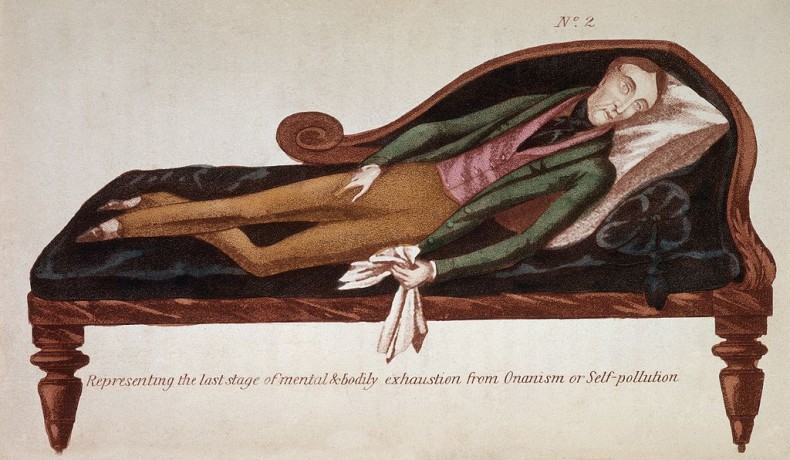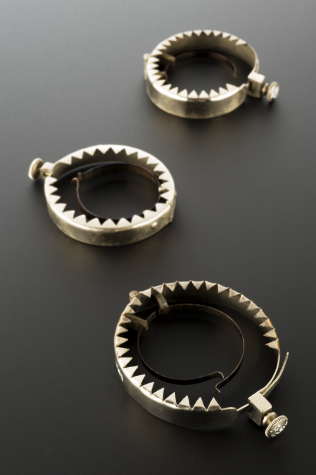Have you ever read a book where someone had pleurisy, or gout, or hysteria, and wondered…how come I never hear about anybody getting that anymore? Well, you’re in luck: It’s Outmoded Diseases Week at LWON, and we’re going to tell you. About some of them, anyway.
 Gents, are you prone to fainting fits and epilepsy? Are you lacking “balmy and vital moisture”? Do you have weakness in the penis? Has your seed spawned sickly babes that either die quickly or always complain?
Gents, are you prone to fainting fits and epilepsy? Are you lacking “balmy and vital moisture”? Do you have weakness in the penis? Has your seed spawned sickly babes that either die quickly or always complain?
Then you might be suffering from spermatorrhea (or if you’re British, spermatorrhoea), the excessive involuntary loss of semen.
But losing semen is just the beginning. “In spermatorrhea, the body becomes a sieve, losing vitality from every orifice. Semen leaks away not only in ejaculations and nocturnal emissions but in urination; sweat oozes from every pore, creating the clammy palms of the self-abuser . . . Over and over again, doctors imagined the body as a leaking vessel,” writes Ellen Bayuk Rosenman in Body Doubles: The Spermatorrhea Panic.
The disease was first described by French physician Claude François Lallemand in the mid-1800s in a massive, three-volume work titled Des Pertes Seminales Involontaires. Lallemand offers a raft of case studies that “bespeak a lifetime devoted to observing genital disorders,” writes Robert Darby. “But it is a strange work, more like an anthology of bizarre sex stories than a scientific treatise.”
Spermatorrhea is a disease with many causes, but masturbation is far and away the most common. “Nearly all of Lallemand’s patients seem to be guilty of it,” Darby writes. (Though, if I can quibble, semen loss due to masturbation hardly seems “involuntary.”) Masturbation has long been condemned by the church, of course, in the 1700s physicians too turned against the practice. They began to concoct a medical argument against “self-pollution.”
By the 1800s, masturbation had been linked to a long list of ailments. In his 1867 book, The Art of Prolonging Human Life, Christoph Wilhelm Hufeland details the physical and mental consequences:
“Frightful is the stamp which nature impresses on a sinner of this class. He is a faded rose — a tree withered in the bud — a wandering corpse! All life and fire are killed by this secret vice, and nothing is left but weakness, inactivity, deadly paleness, wasting of body, and depression of mind. The eye loses its lustre and strength; the eye-ball sinks; the features become lengthened; the fair appearance of youth departs; and the face acquires a pale yellow, leaden tint. The whole body becomes sickly and morbidly sensitive; the muscular power is lost; sleep brings no refreshment; every movement becomes disagreeable; the feet refuse to carry the body; the hands tremble; pains are felt in all the limbs; the senses lose their power; all gaiety is destroyed. Such persons speak seldom and only when compelled; all former activity of mind is destroyed.”
I could go on. Hufeland does for 230 more words. Let me skip to the end, which isn’t pretty.
“Moreover the digestive power is destroyed; flatulence and pains in the stomach create constant annoyance; the blood is vitiated; the chest obstructed; eruptions and ulcers break out upon the skin; the whole body becomes dried and wasted; and in the end come epilepsy, consumption, slow fever, fainting fits, and an early death.”
Is it any wonder the youths of Victorian England were terrified?
Unfortunately, the treatments for spermatorrhea were almost always worse than the (non-existent) disease. Lallemand describes one youth who refused to stop masturbating despite a number of interventions. Finally, at his wits end, Lallemand inserted a catheter into the lad’s penis to render it so inflamed and painful that the boy couldn’t touch it. The French physician was also a proponent of circumcision and driving long needles through the perineum into the prostate. Lallemand’s best-loved therapy, however, involved injecting a silver nitrate solution into the urethra to cauterize the passage.
Spermatorrhea and the masturbation phobia that accompanied the disease also spawned the invention of a horrifying array of devices. The rings on the left are designed to slip over the penis at night. Should the wearer become aroused . . . well, you can no doubt imagine what would happen.
Mainstream medicine no longer considers masturbation a disease. But if you think spermatorrhea has disappeared, think again. The diagnosis didn’t go away, it went online.
In what has to be the most accurate, most horrific URL ever — semenleakage.com — you can find information on how to treat nocturnal emissions, frequent nightfall (uncontrollable ejaculation during sleep), and, yes, spermatorrhea. Thankfully the modern-day “therapies” are far more palatable: capsules containing saffron and other herbs.
***
First image courtesy of Wikimedia.
Second image courtesy of the Science Museum London
One thought on “Outmoded Diseases: Spermatorrhea”
Comments are closed.